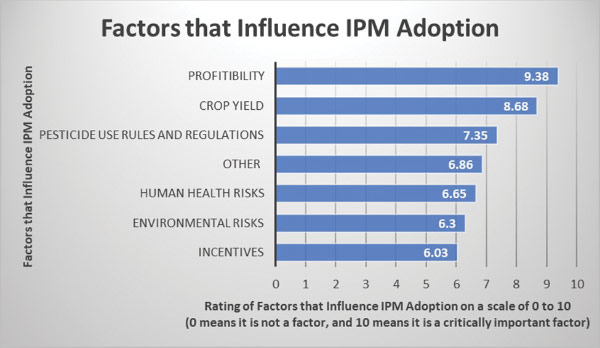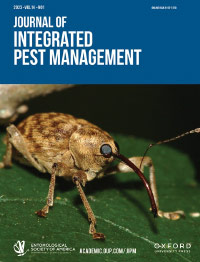Survey Details Integrated Pest Management Adoption, Challenges in U.S.
 |
|
David Lane, evaluation specialist at the Northeastern IPM Center. |
By David E. Lane, PhD, Evaluation Specialist, Northeastern Integrated Pest Management Center
A version of this article was originally published on Entomology Today, a blog by the Entomological Society of America, at entomologytoday.org/2023/03/07/survey-details-integrated-pest-management-adoption-challenges-united-states/.
In January, the Northeastern Integrated Pest Management (IPM) Center published a new paper evaluating IPM adoption and impacts and offering strategies for increasing IPM adoption.
Published in the open-access Journal of Integrated Pest Management, the paper is based on a study led by the Northeastern IPM Center with assistance from the other three regional IPM centers. My colleagues Tegan Walker, PhD, evaluation specialist for the Southern IPM Center, and Deborah G. Grantham, director of the Northeastern IPM Center, joined me in co-authoring the report, titled “IPM Adoption and Impacts in the United States.”
Methods and Audience
To evaluate the extent to which the regional IPM centers are increasing adoption of innovative IPM practices, from February through June of 2021, an online, targeted, national survey of the state IPM coordinators in each region was conducted.
Each state has an IPM coordinator who oversees IPM programming throughout that state with funding support from multiple sources, including the Extension Implementation Program within the U.S. Department of Agriculture’s Crop Protection and Pest Management Program (CPPM). The survey questions pertained only to IPM in agriculture, not urban or structural IPM.
Increased IPM adoption hinges not only on the future of innovative research but also on the willingness of growers to adopt new IPM methods. By better understanding the drivers of—and potential barriers to—IPM adoption, we and our fellow researchers, educators, and extension personnel can better target future behavior change.
IPM Adoption Drivers and Barriers
“Profitability” is the top factor that influences farmers’ willingness to adopt IPM practices. Other motivators that drive IPM adoption include pesticide use and regulations, along with perceived risk reductions to human health and the environment associated with the adoption of IPM.
Barriers and Opportunities for Improvement
Increased IPM adoption hinges not only on the future of innovative research but also on the willingness of growers to adopt new IPM methods.
Overall, respondents ranked “high cost of practice” as the most critical barrier to IPM adoption. “Difficulty of implementation” and “lack of awareness” were also highly ranked.
They ranked “improved cost-benefit analysis” as the most critically important way to increase adoption.
Environmental Impacts of IPM
The results from this study suggest that IPM is better for the environment while being effective. The states represented in this survey are addressing the impacts of pest management on water quality and soil health most of the time, and the impacts on habitat for beneficial terrestrial organisms, endangered species, and air quality about half the time.
The state IPM coordinators are encouraging growers to practice both pesticide and pest-resistance management, which often involves selecting or breeding plants that are more resistant to pests. The vast majority are encouraging biocontrol and the use of beneficial insects. Most encourage practices that enhance soil health and water quality.
Human Health Impacts of IPM
As a result of IPM adoption, almost all the state IPM coordinators reported observing a reduction in overall risks from pesticides, including pesticide exposure for growers and farm workers. Over half indicated that their state always addresses the following human-health-risk concerns:
- Use of lower-risk IPM tactics
- Specific details of pesticide labels
- Selection of reduced-risk materials
- Use of personal protective equipment
About a quarter of participants address these human-health impacts most of the time.
 |
Impact of the Regional IPM Centers
Almost all the participants agree that the regional IPM centers increase overall IPM adoption and regional IPM communication, cooperation, and collaboration. These data strongly suggest that the centers are increasing IPM implementation effectively.
States can conduct IPM individually, but when whole regions work together, it is easier to tackle problems that move beyond state lines such as migrating pests, invasive species, and climate change.
Takeaways and Proposed Solutions
The more profitable, testable, and understandable the adopter considers the IPM practices, the more likely they are to adopt them.
This study highlights the current drivers of, barriers to, and impacts of IPM adoption in the United States.
The state IPM coordinators’ responses strongly suggest that improved cost-benefit analyses of IPM practices should increase IPM adoption. Furthermore, with better cost-benefit analyses—considering costs and benefits related to IPM’s impact on profitability, human health, and the environment—we can better predict which incentives might have the most impact on increasing IPM adoption.
Relatedly, more high-quality, practical research, education, and training could promote more grower-to-grower communication, which, along with proper incentives, should help inform and incentivize decisions to adopt IPM.
In general, the more profitable, testable, and understandable the adopter considers the IPM practices, the more likely they are to adopt them.
 |
Read More
The paper, “IPM Adoption and Impacts in the United States,” is available to read online in the Journal of Integrated Pest Management at doi.org/10.1093/jipm/pmac028.
The Northeastern IPM Center promotes integrated pest management for reducing risks to human health and the environment. If republishing our news, please acknowledge the source (“From Northeast IPM Insights”) along with a link to our website.
